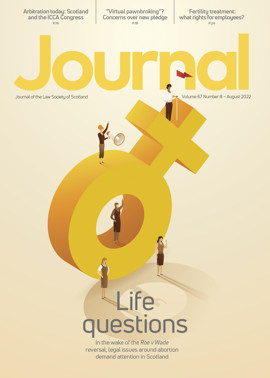Employment: Long COVID as a disability
An employment tribunal recently handed down the first reported decision on whether long COVID amounts to a disability under the Equality Act 2010. Long COVID is having an impact on many employers and their workforces, but it is by no means the only invisible illness employers must contend with.
Burke v Turning Point Scotland
In Burke v Turning Point Scotland ETS/4112457/2021 (10 June 2022), an employment tribunal recognised the claimant, Mr Burke’s long COVID as a disability under the Act. Burke tested positive for COVID-19 in November 2020 with mild symptoms. After isolating, he began experiencing severe headaches and fatigue, and had to lie down after standing for long periods of time. He struggled to undertake daily household activities, or socialise. He experienced a number of other symptoms including a loss of appetite, joint pain, difficulty sleeping and struggling to concentrate. His symptoms often improved, before worsening again. His daily activities continued to be affected by fatigue and sleep disruption.
He was off work from November 2020 due to his symptoms. Although fit notes referred to the effects of long COVID and post-viral fatigue syndrome, two occupational health reports confirmed that he was able to return to work and stated that it was considered that the disability provisions in the 2010 Act were unlikely to apply. Despite the occupational health reports, he did not return to work due to symptom relapses. Turning Point dismissed him in August 2021, on the basis that he was too ill to return to work and Turning Point could not see that changing.
Burke brought claims for unfair dismissal and disability discrimination. As a preliminary issue, the tribunal had to consider whether he was disabled for the purposes of the Equality Act 2010. The tribunal concluded that he was. It found that he was suffering from a physical impairment, namely post-viral fatigue syndrome as a result of contracting COVID-19. The tribunal accepted Burke’s evidence that it had an adverse effect on his day-to-day activities, which was more than minor or trivial. The tribunal also had no difficulty in concluding that the adverse effect was long term, particularly given the employer’s view that they could see no prospect of him returning to work.
As a first instance decision, the tribunal’s judgment will not be binding in future cases. In any event, any assessment of whether an invisible (or visible) illness is a disability will be based on the particular circumstances of the case. Nevertheless, the decision confirms the view expressed by the Equality & Human Rights Commission (“EHRC”) that long COVID, although not automatically deemed to be a disability, can amount to one depending on its impact. The EHRC recommends that employers follow existing guidance when considering reasonable adjustments for employees with disabilities and access to flexible working.
Dealing with invisible illnesses
Long COVID has brought into focus the challenges that have long existed when managing invisible illnesses. A wide variety of conditions fall into this category, including ME, depression, anxiety and other mental health conditions, as well as physical conditions such as lupus and Crohn’s disease. Invisible illnesses are, by definition, harder for an employer to identify. This makes open communication with employees crucial to help affected employees remain in work and to do so comfortably and productively.
What can employers do?
Appropriate policies and procedures, including for making reasonable adjustments, are key, but it is vital that employers walk the walk as well as talk the talk. Being aware of invisible illnesses and their impact on affected employees is the first step. Proactive employers should consider investing time in training managers to recognise these issues. As with so many employment-related issues, and as already noted, open communication is imperative. An ongoing dialogue between employee and employer can go a long way to reducing the risk of grievances or tribunal claims. Just as importantly, this helps to create a supportive and inclusive environment. In some cases, an employer will need expert medical guidance on what measures will help. Engaging early with occupational health specialists may pay dividends in the long term.
Employers have learned a lot about flexible working over the last two years. Facilitating flexible working arrangements for employees with invisible illnesses will often help to avoid absences and other issues arising. This might involve homeworking, at which most of us are now adept, or it might involve a change to working patterns. Perhaps an employer could allow an employee to work, say, early in the morning if their symptoms are less severe at that time of day. In a market in which employee retention has never been more important or challenging, being mindful and supportive, and willing to consider creative solutions, can make all the difference.
Regulars
Perspectives
Features
Briefings
- Criminal court: Long road against addiction
- Family: CGT reforms in the pipeline
- Employment: Long COVID as a disability
- Human rights: civil rights not engaged by legal aid bid
- Pensions: A neverending story – fraud update
- Scottish Solicitors' Discipline Tribunal: August 2022
- Property: The RoS arrear: any light in the tunnel?
- In-house: As the workplace evolves






